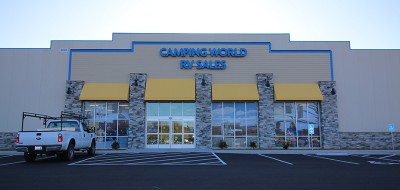 After Mark Polk’s great post on getting the most from your RV refrigerator, I though I would get my hands dirty a bit, and give some fairly simple hands on instructions on cleaning the burner of a mid to late 1990’s Norcold. While often the burner can be cleaned with either compressed air or a vacuum, if maintenance has been put off, sometimes you need to take the burner out for a good cleaning. Symptoms of needing a burner cleaning include poor/no performance on LP gas, and failure of the flame to ignite and stay burning.
After Mark Polk’s great post on getting the most from your RV refrigerator, I though I would get my hands dirty a bit, and give some fairly simple hands on instructions on cleaning the burner of a mid to late 1990’s Norcold. While often the burner can be cleaned with either compressed air or a vacuum, if maintenance has been put off, sometimes you need to take the burner out for a good cleaning. Symptoms of needing a burner cleaning include poor/no performance on LP gas, and failure of the flame to ignite and stay burning.
A few safety tips before we begin- even though this is a reasonably simple procedure, you are working with the LP gas system, and proper safety precautions need to be taken- among them turn the LP supply off, disconnect the power to the refrigerator, don’t smoke while working….in other words, don’t blow yourself up (and if you do, don’t blame me or RV.Net!)
Ready? Let’s go…
 The model I am using is a Norcold 662, but the procedure will be the same for many other models. Most Norcold models built since the early 1980’s use a “horizontal” burner. Norcold did change the design a few years ago- while the burner looks the same, the orifice assembly was changed to a new design- the main difference being that the new designs use a flare connection instead of a ferrule/ copper gasket.
The model I am using is a Norcold 662, but the procedure will be the same for many other models. Most Norcold models built since the early 1980’s use a “horizontal” burner. Norcold did change the design a few years ago- while the burner looks the same, the orifice assembly was changed to a new design- the main difference being that the new designs use a flare connection instead of a ferrule/ copper gasket.

Before you can clean the burner, you need to get to it- first, I remove the condensation drain cup, next, remove the sheet metal cover which hides the burner assembly.
 Now you can see the burner as well as is possible. Looking at this burner, we can see that it is producing a very “lazy” flame, not the hard blue flame that is needed (on most Norcold models, you can hear a slight roar when the flame is burning correctly).
Now you can see the burner as well as is possible. Looking at this burner, we can see that it is producing a very “lazy” flame, not the hard blue flame that is needed (on most Norcold models, you can hear a slight roar when the flame is burning correctly).
Now would be the time to try blowing the burner out with compressed air, or vacuuming it out with a shop vacuum. If that restores the good flame- great! put it all back together, and enjoy the beverage of your choice!

But… if that doesn’t fix it, we will need to remove the burner and orifice and give them a good cleaning. Making certain the LP and power (both 12 and 120 volt) are turned off, we will remove the nut attaching the LP tuning to the burner. Note that the tubing is soft aluminum and the nut is brass, so you need to watch carefully when loosening the nut to make sure the nut breaks loose from the tubing and you do not twist the tubing (voice of experience speaking). You may need a short spray of your favorite lubricant to help it break loose.
Once the nut is loose, you can pull the tubing back a bit allowing access to remove the burner. The burner is held in by a single phillips head machine screw- once you have that removed, the burner will pull straight out.
The burner is held in by a single phillips head machine screw- once you have that removed, the burner will pull straight out.
 Sometimes when the tubing is pulled out, the copper gasket and orifice will stay on the tubing, many times it will stay in the burner- in the left hand photo, you can see the gasket and orifice still in the burner. This copper gasket is very important and is a replacement item- you must install a new one on this type of Norcold burner when you disassemble it like this.
Sometimes when the tubing is pulled out, the copper gasket and orifice will stay on the tubing, many times it will stay in the burner- in the left hand photo, you can see the gasket and orifice still in the burner. This copper gasket is very important and is a replacement item- you must install a new one on this type of Norcold burner when you disassemble it like this.
The good news is that an orifice and gasket are only about $5, cheap enough that I never even clean the orifice on these models, I just replace it. Newer Norcold models use a flair fitting and brass orifice so the gasket is not used.
 Most times it is possible to clean the burner using a wire brush and some elbow grease- in this case the slots in the burner were rusted through, so a new burner was in order.
Most times it is possible to clean the burner using a wire brush and some elbow grease- in this case the slots in the burner were rusted through, so a new burner was in order.
14 years is not too bad for a steel burner in a hostile environment, and at around $30, it just makes sense to go ahead and put in new.
If you have access to compressed air, now would be a good time to blow out the flue tube- the tube that the flame goes in to. Just be careful to cover the open end of the LP tubing so you do not blow dirt in to it.
 Reassembly is just the reverse of disassembly- replace the burner, put the new gasket and orifice on the end of the tubing, and tighten the nut on the tubing in to the burner. I usually put a very small dab of anti-seize compund on the tubing under where the brass nut rests, simply to make disassembly easier the next time- but only use enough for a thin coating on the tubing and keep it away from the ferrule.
Reassembly is just the reverse of disassembly- replace the burner, put the new gasket and orifice on the end of the tubing, and tighten the nut on the tubing in to the burner. I usually put a very small dab of anti-seize compund on the tubing under where the brass nut rests, simply to make disassembly easier the next time- but only use enough for a thin coating on the tubing and keep it away from the ferrule. We can now turn the LP and power back on, turn the refrigerator to LP operation, and leak test the connection using an approved leak testing solution (yes, soapy water can work, but the soap must not contain ammonia, which makes brass brittle- leak solution is cheap and easily available.
We can now turn the LP and power back on, turn the refrigerator to LP operation, and leak test the connection using an approved leak testing solution (yes, soapy water can work, but the soap must not contain ammonia, which makes brass brittle- leak solution is cheap and easily available.
After testing, we can shut the refrigerator off and check the spark gap between the igniter and burner- it should be 3/16″ and centered above the burner.

A comparison of the “bad flame” versus the “good flame” shows the difference- on the left is the “lazy” bad burning flame, on the right is the “hard blue” flame- and with the small amount of LP that is used in a Gas Electric refrigerator, a small problem with the flame can mean a huge difference in cooling power.
Now simply replace the sheet metal, and you are good for another year.
This job is not at all hard, though it does involve working with the LP system- if you have any doubts- have a qualified service center do the job, but if you are handy and a “DIY” kind of person- I hope this gives enough information to help you get the job done.
Questions, comments? See this thread on the RV.Net forums.



Anonymous
Thanks.Very good
Pingback: cialis from canadian pharmacies
Pingback: sailing gloves
Mark Danford
thanks for the help cleaning out the tube did not keep the flame going. but it was FULL of rust. cleaning the electrode seems to have fixed it though . thanks again
Pingback: Obsolescence : rx4rv.com
Charlie
Chris, I tried this and got mine all cleaned up, but it still won’t stay lit. When I turn it on the electric igniter does it’s job and the burner lights..then in about 5 seconds I hear another click and it shuts off.
?
Dave
Consensus seems to be that the burner, as pictured in Chris’ post on cleaning a norcold burner is only available with a male [as opposed to the original female ]intake end. Parts suppliers are not sure whether I should use a new supply tube with this or what. Can anyone recommend a straight adapter so that I could use my existing supply tube and the new part, or is there a source for the part as shown on Chris’ original post?????????Dave
Dave
Excellent mentoring—please, where might I find as same as original, female orifice case-burner assemby, same as what i have, same as what is in the picture on your site?
Dusty
Chris do you have any tips for getting the tubing break loose
from the brass nut? I tried several types of penetrating spray
without success. Any reason the aluminum tubing can not
be replaced with copper with the flared fittings to prevent
this from happening again?
silvertrailer
I wish i had not tossed out my 45 year old dometic. My new norcold is a piece of junk. The steel burner rusted and burnt thu in two seasons. The old dometic had a ceramic burner that was still functional. I though that technology and efficiency would have improved some in 45 years but the new norcold was technically worst than the old dometic. I wish the japanese would look into making a good Rv refrigerator.
Chris Bryant
Hi Pkunk- neither new Norcold nor new Dometic models have an adjustable air intake- I [i]think[/i] that Norcold has an alternate orifice available for high altitude operation.
Jerry- a lot depends on the model- if it’s an automatic model, does it indicate AC operation and just not cool? If so- likely the heating element is burned out. If it jut won’t switch to AC, then it could be as simple as a GFCI tripped, or a blown fuse.
You might want to head over to the RV.Net Tech Forum and ask there- you will get a lot of help- but give the model number of the refrigerator.
–Chris
JERRY THORNTON
DOMETIC RV FRIG, PROPANE COLD ELECTRIC DOES NOT
COOL DOWN OUR FRIG. WHATS WITH THAT?
Pkunk
Very good tutorial, but you made no mention of the air adjustment. I travel (& live) above 8000 ft, and adjust my air almost all the way open to get a good flame.